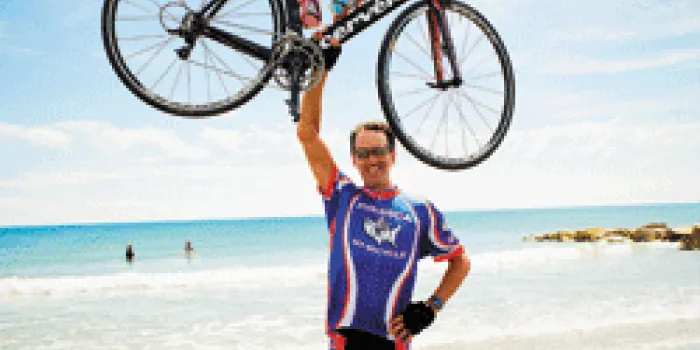In each issue of HemAware, we “Take 5” with people in the bleeding disorders community and spotlight their efforts with just five questions. Here, we talk to Barry Haarde, who completed a 3,700-mile bike ride from Oregon to New Hampshire in August 2012, as part of the Ride Across America. Haarde has severe hemophilia A, HIV and hepatitis C. He lives in Houston.
How did you first become interested in cycling?
My interest in cycling stemmed from having my knee replaced back in 1999. My orthopedic doctor suggested that I get my leg muscles in better shape prior to the replacement surgery, so I began cycling. My post-op physical therapy involved using a stationary bike. When I was able, I got back on my trail bike and started cycling again. At first, 10- to 20-mile rides were the norm. Then I purchased my first road bike and began to take on longer and longer rides. I completed my first 100-mile ride back in 2004 and have gone on to complete rides of 150 miles in one day. In 2012, I finished 30 rides of 100 miles or longer.
Why did you take on such a big challenge as a coast-to-coast ride?
I’d never heard of anyone with hemophilia having undertaken an effort of this kind, so the challenge was out there to become the first to do it. I decided to raise money for Save One Life, an organization that provides help to people with hemophilia in developing countries. I contacted the founder and president, Laurie Kelley, and she loved the idea. By the ride’s end, we’d raised more than $45,000. Sponsorship for the tour was provided by Baxter.
I am also a board member of the Committee of Ten Thousand (COTT). I wanted to do something to promote COTT’s concept of establishing a national hemophilia memorial. Each day of the tour was dedicated to a community member who’d lost his or her life to AIDS or hepatitis C. I posted photos and dedications on Facebook at the start of each
day’s ride.
How did you manage your bleeding disorder during training and on the ride?
I’ve had very few bleeding episodes arise because of the cycling. For many years, I was using factor on an on-demand basis. With the increase in activity level needed to ride at the level required to cross the country, I transitioned to prophy, which I maintained while on the Ride Across America. Interestingly, I never had a bleed during the seven weeks of the trip.
What were the highlights and challenges of the ride?
The ride overall was really not that difficult. But there were some individual days that were challenging, such as the climb up Mt. Rushmore, ascending Teton Pass and crossing the Continental Divide at 9,600 feet. There was that 120-mile ride into Casper, Wyoming, into a headwind that also sticks out in my mind.
The best part of the ride was the money we raised to support Save One Life. The way in which the hemophilia community has responded to the ride effort has been hugely gratifying and encouraging, too. I never thought I’d ever evolve into a “motivational speaker” after so many years of laboring under the stigma of HIV and living as quietly as possible as a result. But now I’m speaking at hemophilia events around the country, and it’s a real joy.
What advice would you give someone with a bleeding disorder who wants to get into long-distance cycling?
A good local bike shop and the local cycling club together are the best places to learn what to do and what equipment to use. No one should ever go out and jump on a bike and try to ride 100 miles. Start slowly, ride short distances until you build up your strength. As always, consulting with one’s doctor about a fitness routine is just common sense, especially for those with underlying health conditions like hemophilia.
For more information about the Ride Across America and other upcoming fundraising tours, contact Barry: [email protected]. Pictures of the Ride Across America and more information can also be found on Barry’s Facebook page: facebook.com/haarde.
To learn more about Save One Life: saveonelife.net.
Do you know an interesting individual we should profile in a future issue of HemAware? E-mail Managing Editor January W. Payne.

